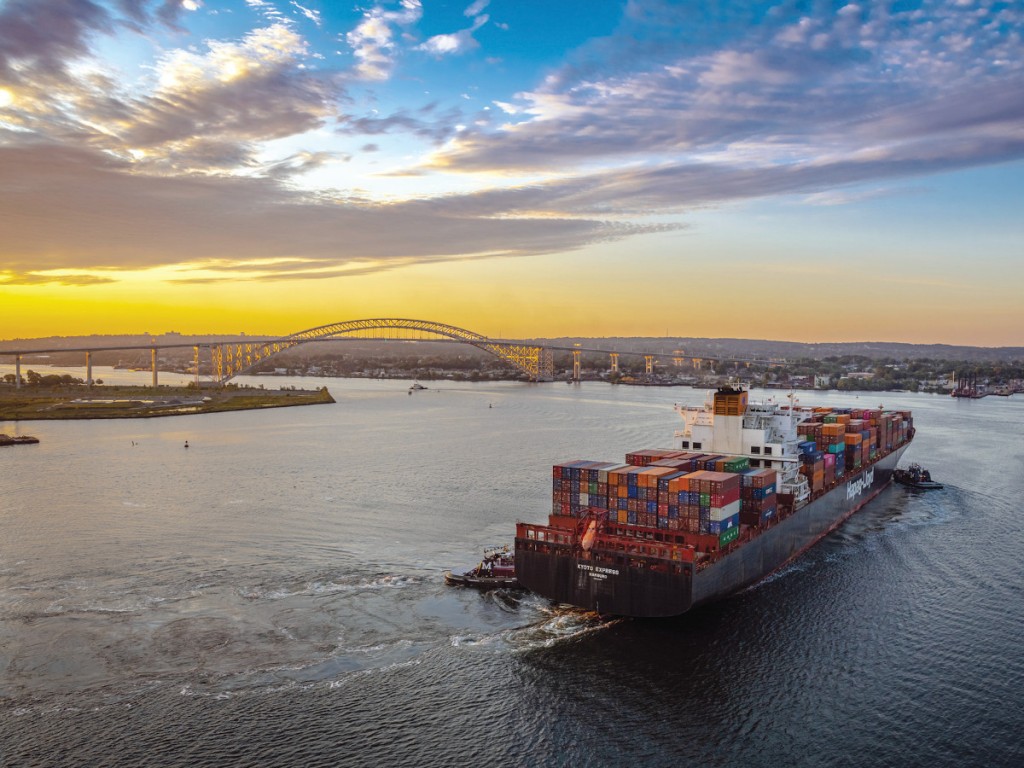Business, Economy Strong
‘Yes’ to Big Ships
Volume May Double
‘Yes’ to Big Ships
Of late, the Port of New York and New Jersey has been saying “yes” to a whole lot more larger containerships. The trend times with deepening of channel areas to 50 feet, completed in 2016, and raising the navigational clearance of the Bayonne Bridge to 215 feet, completed in 2017.
Not surprisingly, Rooney sees the port continuing to set records and build upon its intermodal gateway position:
“I think the volumes speak for themselves,” she said. “The big difference that we have seen, particularly because of the channel deepening and the raising of the Bayonne Bridge, is the size difference of the vessels.”
Four years ago, she said, the majority of the port’s cargo was being carried on boxships with a capacity of between 5,000 twenty-foot-equivalent units and 6,000 TEUs. Today, according to Rooney, “the lion’s share” is being carried on ships with a capacity of 8,000 or more TEUs.

Prior to completion of the Bayonne Bridge project, ships with capacities of about 9,400 TEUs were unable to reach container terminals at Newark and Elizabeth in New Jersey and Staten Island in New York.
Through the first seven months of calendar 2019, more than 32 percent of the port’s cargo came on ships with a capacity of 9,000 TEUs or more, Rooney said. That compares with just 4.9 percent of the port’s cargo coming in on such larger vessels just four years earlier.
Part of the challenge posed by the bigger ships relates to getting all those boxes loaded and unloaded.
“We are still a truck port,” Rooney said, noting that 85 percent of the port’s volume leaves via trucks. “While we’ve been making the investment outside the gates on the common-user infrastructure, all of the investments that the terminal operators have been making inside the gates in cargo-handling equipment, new gate systems, new terminal-operating systems, extended capacity and new ship-to-shore cranes allows for them to efficiently handle the larger ships which have the larger volume of cargo being discharged.”
Billions Invested
Marine terminal operators have invested more than $2 billion in their New York and New Jersey facilities over the past 15 years, she said, with another $2 billion anticipated to be similarly spent over the coming decade.
That is in addition to the $6 billion invested by The Port Authority of New York and New Jersey in infrastructure undertakings including the channel and Bayonne Bridge endeavors. Another $1.1 billion is in the capital program for the next 10 years.
For the 15 percent of cargo moving by rail, efficiencies are being enhanced through port investments and partnerships with the two Class Is – CSX and Norfolk Southern – now directly servicing five of the port’s six container terminals via on-dock and near-dock installations. The sixth, the Red Hook Terminals facility in Brooklyn, is served via a common-user rail facility.
Moving greater volumes via rail assuredly is part of long-range plans, including those posited in the 30-year master plan, unveiled in July following more than 2 1/2 years of collaboration with stakeholders by the landlord port:
“There was actually a focus on really ratcheting up the stakeholder outreach,” Ruda said. “We cast a pretty wide net, obviously including all the typical suspects, such as existing customers, users of the port, the trucking community and other industry stakeholders, but also a lot of outreach into our host communities and even subsets within those host communities, including environmental justice communities.
“We heard a few consistent themes representing the major focus of the feedback,” Ruda said. “On a positive note, the stakeholders want the port to be successful. They want the port to grow. Communities want to have access to the jobs – not just the waterfront jobs but the jobs the industry generates in logistics, warehousing and so on. And the host communities are going to hold the port accountable for the environmental impacts.”
The plan calls for continuing operation as a landlord port, Ruda said, commenting, “Being a landlord port doesn’t give you a free pass on your share of the contributing infrastructure. We’re going to continue to be heavily engaged in waterways infrastructure, navigation infrastructure, berths and wharves, roadways and rail.



_-_28de80_-_58820516bd428ab3fd376933932d068c43db9a4a_lqip.jpg)

